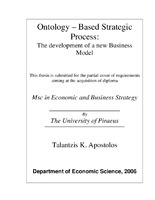| dc.contributor.author | Ταλαντζής, Απόστολος Κ. | |
| dc.date.accessioned | 2007-05-21T09:37:55Z | |
| dc.date.available | 2007-05-21T09:37:55Z | |
| dc.date.issued | 2007-05-21T09:37:55Z | |
| dc.identifier.uri | https://dione.lib.unipi.gr/xmlui/handle/unipi/1352 | |
| dc.description.abstract | This research started putting as a target the exploration and the analysis of the sensitivity of the firm to internal and external environment compared to that of the industry and to that of its competitors. That kind of analysis can show to the firm its vulnerability to environmental changes compared to the industry. To do so we used ontology. In philosophy, ontology is the most fundamental branch of metaphysics. It studies being or existence and their basic categories and relationships, to determine what entities and what types of entities exist. Ontology thus has strong implications for conception of reality. Ontology as a concept exists since ancient Greece but it is only recently that it has being applied in economics. A typical case of designing ontology is a business. To create an understanding of enterprises and the ways they do business, a starting point could be to identify the main actors and the values transferred between them. The results that the ontological analysis gave are quite deferent from the classical analysis (Porter, P.E.S.T.E.L. etc.). The analysis shows through relationships that all the factors influence each other either in a direct way or in an indirect way. The thesis is being formed in seven parts. Part 1: in the first part there are being cited the basic concepts; ontology and business environment. Part 2: in this part we have the classical environmental analysis; P.E.S.T.E.L., Porter’s analysis, market types and value chain analysis. Part 3: in the third part we analyze the ontology of business environment and all the factors that affect it. Part 4: in this part we draw the map of ontological business environment and categorize the environmental factors in internal, external and middle environment. Part 5: in the fifth part we draw and describe an ontology based environment matrix and we try to conclude to the appropriate strategy that any company must follow according to its position in the matrix. Part 6: in the sixth part there are the conclusions. There are being cited the ontological analysis outcomes and the usefulness of the O.B.B.E. matrix. Part 7: in the last part there are the future researches that can be done. | |
| dc.language.iso | el | |
| dc.rights | Αναφορά Δημιουργού-Μη Εμπορική Χρήση-Όχι Παράγωγα Έργα 4.0 Διεθνές | |
| dc.rights.uri | http://creativecommons.org/licenses/by-nc-nd/4.0/deed.el | |
| dc.subject | Διατριβές | |
| dc.subject | Strategic planning | |
| dc.subject | Business planning | |
| dc.subject | Business analysis | |
| dc.title | Ontology - Based strategic process : the development of a new business model | |
| dc.type | Master Thesis | |
| europeana.isShownAt | https://dione.lib.unipi.gr/xmlui/handle/unipi/1352 | |
| europeana.type | IMAGE | |
| dc.identifier.call | 658.4012 ΤΑΛ | |



